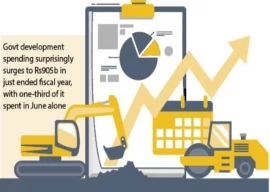
The outgoing setup’s recipe for policy formulation also included a further 8% devaluation, urging the new government to let the currency fall to Rs135 to the US dollar before the current fiscal year ends, showed the policy recommendation paper, prepared by outgoing caretaker finance minister Dr Shamshad Akhtar.
Finance minister urges APG to be flexible in deadlines
It proposed to immediately increase the key policy rate by another 200 basis points to 9.5% to curb aggregate demand, which according to the caretaker finance minister has led to “overheating” of the economy. A sharp cut in development expenditure has been proposed with relatively low tax efforts in the ongoing fiscal year.
If these three measures are not taken, foreign exchange reserves would fall to $6.3 billion by the end of December 2018, warned the caretakers. There is a risk that the economy will destabilise even further to a point where markets will panic and investor confidence will erode, according to the caretaker government’s assessment.
Prime Minister Imran Khan took oath of the office and also unveiled his 21-member federal cabinet on Saturday. In line with expectations, Asad Umar was nominated as the Federal Minister for Finance, Revenue and Economic Affairs.
The caretaker government proposed another reform scenario to deal with the “current financial crisis”, with advice that will yield results in the short to medium term. The second option includes massive tax efforts, but no major cuts on expenditures. This option includes the introduction of a wealth tax.
Pakistan faces a twin-deficit crisis, in which its current account deficit has ballooned to an unsustainable level of $18 billion while its fiscal deficit has widened to 6.8% of the GDP or Rs2.3 trillion.
Default on foreign debt obligations is not an option, as it will lead to severe breach of agreements, which have their consequences, including compounding economic crisis and loss of investors’ confidence, it added.
The caretaker setup suggested to the PTI government to take these “reform measures within three weeks”, if it wants to avoid recourse to the IMF. Umar also said that the government will have to finalise its options before the end of September.
The caretakers’ assessment showed that Pakistan faces a severe financial crisis. While growth remains strong and inflation low, the economy has overheated to a state where private consumption has pushed the current account deficit to an unprecedented level.
The caretaker government traced roots of the current financial crisis in the last government’s failure to lay the foundation for an export-oriented economy that could have generated the desired level of foreign exchange earnings. It added that the PML-N government pursued policies that increased economic growth and domestic demand to a point where demand far exceeded productive capacity of the economy.
It warned that the previous measures of increasing the interest rates to 7.5% and devaluing the rupee to Rs124 to the dollar would prove inadequate to address the challenges due to low level of foreign exchange reserves and projected higher budget deficit of 7.1% of GDP or Rs2.9 trillion.
1st scenario
The caretaker government suggested steep, but immediate fiscal adjustment to the tune of Rs612 billion or 1.6% of GDP. This should largely come from a Rs460-billion cut in overall expenditures and Rs153 billion worth of tax efforts.
“The main goal for the new government should be based on principles of stabilisation.”
First 100 days: PM Khan approves 21-member cabinet
The government should consider medium-term macroeconomic measures in the shape of a prudent fiscal policy, tight monetary stance and a flexible exchange-rate regime, it stated. The caretakers suggested increasing the FBR’s tax target to Rs4.5 trillion. It proposed to take additional revenue measures of Rs180 billion and reversal in the reduction in income tax rates for individuals, which were introduced by the last PML-N government. The caretakers have recommended reducing the petroleum development levy target from Rs300 billion to Rs200 billion. It proposed to reduce the PSDP from Rs850 billion to Rs350 billion, seeking to limit core projects like CPEC, Diamer-Bhasha dam and Mohmand dam.
It also advised to institute a mechanism with the help of the Council of Common Interests to deduct an upfront Rs215 billion amount from the shares of the federating units to ensure provincial surpluses.
All new recruitments and procurements are proposed to be banned other than those approved by the finance minister. It also advised that all types of food and fertiliser subsidies should be abolished.
Outcomes
The caretakers hope that these measures should lower the budget deficit from projected 7.1% of GPD to around 5% of GDP or Rs2 trillion.
As a result of these measures, the external current account deficit would be lowered to a point where the financing gap will be reduced to a more manageable level. But the economic growth will slow down to 5% and inflation will inch up to 7.4%.
In this scenario, the IMF programme will not be required on the pretext of sharp reduction in government expenditures and projected financial inflows in the capital account, according to the caretaker finance minister’ assessment.
It has projected that due to these measures, the current account deficit will reduce by half to $8 billion, SBP’s reserves would increase to $11.2 billion and the financing gap will only be $2.8 billion.
2nd scenario: the IMF programme
In the second scenario, the government will have to make considerable tax efforts and the additional fiscal space will be used to increase development expenditures. The real interest rates will be maintained at 1.5%, close to 9%. Under this scenario, the IMF programme will be required due to a higher financing gap. The current account deficit will be $11 billion by the end of this fiscal year, SBP’s reserves will be $8.2 billion and the financing gap will be $6.7 billion.
This scenario suggests increasing the FBR’s tax collection target to Rs4.9 trillion. The caretaker government has suggested introduction of a wealth tax to get additional revenues. In this scenario, the tax effort should be equal to Rs560 billion.
Published in The Express Tribune, August 19th, 2018.
Like Business on Facebook, follow @TribuneBiz on Twitter to stay informed and join in the conversation.


















COMMENTS
Comments are moderated and generally will be posted if they are on-topic and not abusive.
For more information, please see our Comments FAQ